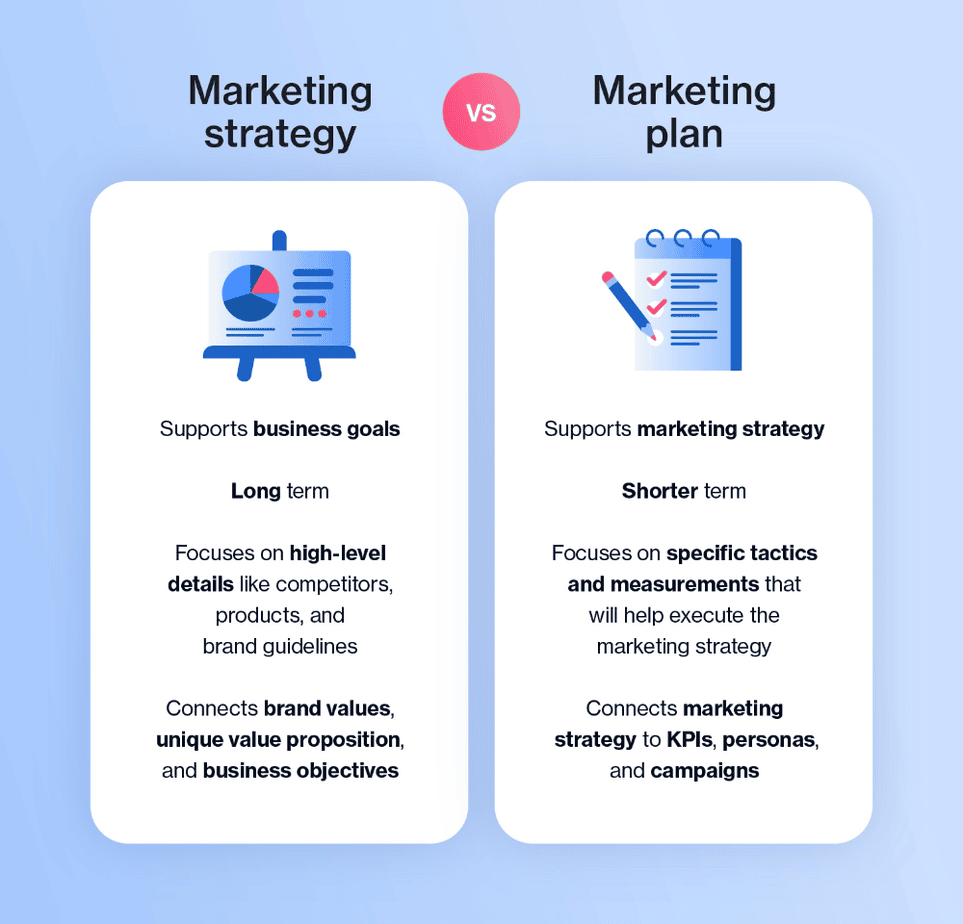Understanding the difference between a marketing strategy and a marketing plan can be tricky. While these terms might sound similar, they serve distinct purposes and are essential for the success of later-living communities. Let’s break down what each one is and why you need both to thrive.
What’s a Marketing Strategy?
Think of a marketing strategy as the big picture. It’s a long-term plan that sets out how your later living community will achieve its marketing goals. It’s like a roadmap guiding your marketing team’s decisions and helping them allocate resources wisely. Here are the key parts of a marketing strategy:
- Market Analysis: Understanding market trends, customer preferences, and your competitors.
- Target Audience: Defining who your audience is based on demographics, interests, and behaviours.
- Value Proposition: Highlighting what makes your community unique and why people should choose you over others.
- Marketing Objectives: Setting clear, measurable goals (think SMART: Specific, Measurable, Achievable, Relevant, and Time-bound).
- Strategies for Product, Pricing, Promotion, and Distribution: Creating plans for how to market your products or services, pricing them, promoting them, and getting them to your customers.
Why You Need a Marketing Strategy
A solid marketing strategy gives your marketing efforts direction and focus. It aligns with your overall business goals and ensures that your messaging and branding are consistent. This helps your community stand out in a crowded market. Plus, it helps your team prioritise tasks, allocate resources effectively, and measure success through key performance indicators (KPIs). According to the Content Marketing Institute, 72% of marketers believe that having a good marketing strategy is crucial for business growth.
What’s a Marketing Plan?
While your marketing strategy is the big picture, your marketing plan is the step-by-step guide on how to achieve it. It’s a detailed roadmap of the marketing activities you’ll undertake over a specific period, usually a year. Key elements of a marketing plan include:
- Target Market Analysis: A detailed look at your target market, building on the broad target audience identified in your strategy.
- Competitive Assessment: Understanding what your competitors are up to.
- Marketing Budget: How much you’ll spend on your marketing activities.
- Marketing Activities Calendar: A timeline of your key marketing initiatives.
- Tactics and Channels: The specific methods and platforms you’ll use to reach your audience, such as events, SEO, paid advertising, offline marketing (print), direct mail, and social media.
- KPIs / Results: Key performance indicators to track the effectiveness of your marketing efforts and measure success.
Why You Need a Marketing Plan
A marketing plan serves as your tactical guide, detailing the specific steps, initiatives, and campaigns you’ll undertake to reach your marketing goals. It keeps your marketing team organised and focused, providing a timeline, budget, and KPIs to track and measure success. A report from CoSchedule found that marketers who document their strategies are 313% more likely to report success than those who don’t.
How They Work Together
Understanding how a marketing strategy and marketing plan work together is crucial. Your strategy provides the high-level direction, while your plan translates that direction into actionable steps and timelines. This relationship ensures that your marketing efforts are cohesive and aligned with your community’s long-term vision.
Key Differences
- Time Frame: A marketing strategy is long-term, spanning several years, while a marketing plan is short-term, often covering one year.
- Scope: A marketing strategy covers the whole organisation, setting the overall approach. A marketing plan focuses on the specific tactics and initiatives needed to execute that strategy.
- Function: A marketing strategy acts as a guiding framework for decision-making, while a marketing plan is a practical tool for implementation.

Lead Generation
Lead generation is a crucial component that fits seamlessly into both your marketing strategy and marketing plan. Here’s how:
Marketing Strategy:
- Lead Generation Goals: Define clear goals for lead generation (e.g., generate 20 quality leads per month).
- Target Audience Identification: Specify the characteristics of high-quality leads, ensuring your efforts focus on the right potential residents.
- Value Proposition: Tailor your value proposition to address the specific needs and concerns of your target audience, making your community more attractive to potential leads.
Marketing Plan:
- Lead Generation Tactics: Outline specific tactics for attracting and converting leads. This includes:
- Content Marketing: Create valuable content to attract and engage potential leads.
- Social Media Campaigns: Use platforms like Facebook, Instagram, and TikTok to reach and engage your audience.
- SEO Strategies: Optimise your website and content to rank higher in search engine results.
- Paid Advertising: Utilise online ads to target specific demographics and interests.
- Events: Host or participate in events to engage with your community and attract leads.
- Offline Marketing (Print): Use brochures, flyers, and local print ads to reach potential residents.
- Direct Mail: Send personalised mailings to potential leads.
- Lead Nurturing: Develop a plan for nurturing leads through email marketing, follow-up calls, and personalised tours of your community.
- Measurement and Optimisation: Set up KPIs to track the effectiveness of your lead generation efforts and continuously optimise based on performance data.
Choosing the Right Approach for Your Later Living Community
You need both a marketing strategy and a marketing plan to effectively manage your marketing efforts. Start with a robust marketing strategy to define your target market, value proposition, and competitive positioning. Once that’s in place, create a well-executed marketing plan to translate your strategic goals into actionable steps.
Marketing Techniques to Consider
Here are some effective marketing techniques that can help increase awareness and engagement with your later living community:
- Word of Mouth: Encourage satisfied residents to share their positive experiences with others. According to Nielsen, 92% of consumers trust recommendations from friends and family over any other type of advertising.
- Social Media: Use platforms like Facebook, Instagram, and TikTok to engage with your audience, share stories, and post updates about your community.
- Email Marketing: Build a relationship with potential residents through informative and engaging email campaigns.
- Blogging: Share valuable content that helps your potential residents’ and families’ with their queries, needs, and concerns.
- Regular Newsletters: Keep your community and potential residents updated with regular newsletters, sharing news, events, and success stories.
- Website Stories: Feature stories about activities and events happening in your later living community on your website to show the vibrant life within.
- Video Tutorials: Create videos showcasing the features and benefits of your community to help potential residents feel more connected.
By incorporating these techniques into your marketing plan, you can build trust, engage your audience, and drive more interest in your later living community.
Final Thoughts
By clearly understanding both marketing strategies and marketing plans, your later living community can position itself for success. Each plays a vital role in achieving your marketing objectives, ensuring your community remains competitive and attractive to potential residents. While your strategy sets the overall direction and long-term objectives, your plan focuses on the specific tactics and timelines needed for execution. Using both effectively ensures that your marketing efforts are aligned, maximising your return on investment and driving sustainable growth.
Stay Agile and Adapt
It’s also essential to keep your marketing plan agile to flex with the environment and changing circumstances. Continuously measure, test, and learn from your efforts so you can adapt swiftly and effectively.
Do you have these strategies and plans in place for your later living community? If not, or if you need support to refine and implement them, we’re here to help.
Contact us to create a comprehensive marketing strategy and plan tailored to your community’s unique needs.
A Look Ahead
Join us next time as we examine “Sales Velocity: We’ll explore what sales velocity is, why it’s important, and how it can accelerate your community’s growth.
Ready to enhance your community’s success? Let’s discuss how we can transform your sales and marketing efforts to increase your occupancy rating.


